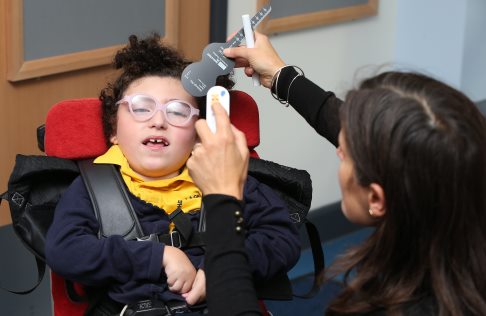New research by SeeAbility, the national learning disability and sight loss charity, suggests that thousands of children with learning disabilities in the North West are missing out on vital eye tests and eye care despite being 28 times more likely to have a serious sight problem than other children.
Around 16,500 children attend special schools in the North West, including the majority of children with severe learning disabilities or autism. SeeAbility’s study indicates that up to half of these children are likely to have a problem with their vision, yet alarmingly an estimated 7,200 children will have never received any eye care.
This means thousands of children who desperately need glasses are going without, many suffering extremely poor vision without anyone knowing about it, impacting on their ability to learn, play and socialise. While others with more serious eye conditions are being deprived of sight-saving treatment.
SeeAbility is calling on NHS England to make wide reforms to community eye care for children and adults with learning disabilities and introduce adjusted eye tests in special schools. Failure to target these high-risk children with eye care they are able to access is causing unnecessary vision impairment and putting eye sight at risk.
SeeAbility has supported over 1,200 school children across England, providing adjusted eye tests and collecting data. It is the biggest global study actively reporting on the eye care needs of children with learning disabilities.
The full findings are in a new report Children in Focus – a clear call to action published today as part of SeeAbility’s Equal Right to Sight campaign.
All children in England are entitled to have a free NHS annual eye test. However, children with learning disabilities are often unable to access or cope with standard eye tests provided in high street opticians or in a hospital clinic.
Many parents of children with learning disabilities are unaware of the increased likelihood of sight problems for their child. Those who are aware are often at a loss to know where to take their child for an eye test they can cope with.
Children who have severe learning disabilities or autism which make communicating or interacting difficult can still have an eye test if adjustments are made. It’s a common misconception that the ability to read a letter chart is necessary or that a child needs to be able to speak to have their eyesight tested.
SeeAbility’s model of sight testing in special schools, recommended by eye care professional bodies, could help reduce the use of under pressure hospital eye clinics, which some of these children are attending because of a lack of a community alternative.
It often works better for children with learning disabilities as it is less stressful, reduces the time they miss from school and incorporates glasses dispensing and repairs for broken spectacles.
It costs around £135 for SeeAbility to provide an adjusted eye test and glasses dispensing in a special school. The charity is doing this on standard NHS funding of £21.31 per eye test and subsidising the rest of the cost of its service through fundraising.
SeeAbility’s CEO, Lisa Hopkins, says: “Our research clearly shows that thousands of children with learning disabilities are not getting the basic eye care they need and which they have a right to access. Many are living life in a total blur, unable to see clearly for want of a simple pair of glasses. This is something that goes on to affect their entire lives, including their ability to learn, make friends and reach their potential.
“In light of this alarming new evidence, we implore NHS England to stop dragging its heels and introduce the reforms needed. This is a major health inequality which NHS England has a responsibility to address and fund appropriately.”
13-year-old Joseph, who has a rare genetic condition called MECP2 Duplication syndrome, is a pupil at New Bridge School in Oldham.
When SeeAbility tested Joseph’s eye sight they discovered that he was long-sighted with blurred vision. Mum Rebecca says: “I was worried about Joseph keeping his new glasses on, he doesn’t even keep his sun hat on!” But SeeAbility actively supports children to wear their glasses, which involves strategies to help parents. Now Joseph wears his flexible and light glasses often.
More on the campaign and information and advice on eye care for children with learning disabilities is on SeeAbility’s website www.seeability.org/equal-







